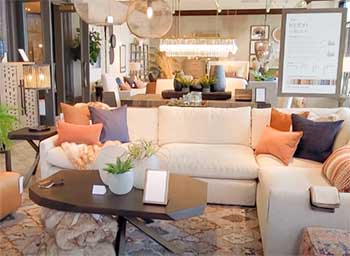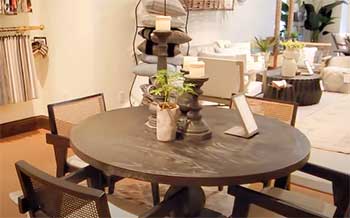Arhaus furniture has a reputation for being on the pricier side. But with their focus on quality materials and craftsmanship, it’s no surprise that their furniture commands higher prices.
Here’s a deep dive into the reasons why Arhaus furniture costs more than mass-produced brands.
Reasons For Arhaus Furniture Being So Expensive
- They Use Premium Materials

One of the biggest factors in Arhaus’ high prices is their emphasis on using quality hardwoods and upholstery.
Their timber comes from sustainable forests in North America and Asia.
Popular woods found in Arhaus furniture include oak, acacia, mindi, shearwood, poplar, ash, and walnut.
These are all dense hardwoods known for durability and natural beauty.
Softwoods like pine are rarely used. Instead, Arhaus opts for wood varieties that develop a rich patina over time. For upholstery, they favor premium Italian or Belgian linens and perennially stylish leathers.
These pricier textiles bring added comfort and luxury to the furniture.
- Craftsmanship Comes At A Cost
Skilled artisans handcraft each Arhaus piece to order. Their workshops employ traditional techniques like mortise and tenon joinery on chair frames.
Drawers feature dovetail joints and buttery smooth full-extension glides. Tables and dressers get reinforced with corner blocks and durable tongue and groove drawers.
This level of meticulous craft is labor-intensive and factors into the higher prices.
Because it’s custom-made, you can’t easily find the same quality and detailing pre-assembled at lower price points. The specialized skills and manpower required mean their furniture takes longer to make than mass-produced counterparts.
But the result is heirloom-quality furniture designed to become family treasures.
- Limited Production Runs
Another consequence of the made-to-order approach is that Arhaus produces limited quantities of each design. This scarcity lets them focus on quality control and not volume output.
But it also means the initial design and production costs get divided over fewer pieces. Bottom line, lower inventory volumes lead to higher per unit pricing.
You’re less likely to encounter the same Arhaus furniture in multiple homes or retailer inventories. The limited production quantities make each piece feel more special and exclusive.
- Sustainable & Ethical Sourcing

Eco-conscious materials sourcing adds to the costs as well.
But it allows Arhaus to reduce their environmental impact and support fair worker treatment.
Their timber comes from FSC-certified forests that adhere to strict regeneration practices.
The company partners with farms to source renewable water hyacinth for weaving lampshades and baskets. They also use recycled polyester, organic cotton, and other consciously sourced textiles.
This ethical sourcing adds steps to the supply chain that ultimately influence end pricing. But it results in quality furniture that makes a lighter footprint.
- Substantial Size & Weight
Typically, larger and heavier furniture costs more. The materials, handling, and shipping for oversized items add to production and retail pricing. As a luxury furniture brand, many Arhaus designs have imposing proportions with generous weight and mass.
Substantial dining tables, expansive sectionals, and room-anchoring dressers all require more raw materials. The hefty use of hardwoods and finishes equates to quality, but also drives up costs.
If you appreciate substantial furniture with presence, expect to pay a sizeable price.
- Investments In Design
Behind every Arhaus piece is an extensive design process informed by trends, historical styles, and cues from architecture and interiors. Their in-house design team works with external collaborators like furniture designers and architects.
This intensive design work gets built into the final pricing.
Staying on top of evolving styles requires continual investments in product design and development. Arhaus translates emerging trends into livable furniture with timeless heirloom appeal.
You pay for both beautiful design and enduring functionality.
- Retail Experience & White Glove Service
The retail settings themselves impact Arhaus pricing. Their impressive showrooms and galleries provide inspiration you simply can’t replicate online. Complementary design services include professional space planning, schematics, and mood boards.
Once purchased, there’s white glove home delivery with room-of-choice and furniture unboxing. This high-touch retail experience requires greater overhead. But it helps justify the premium prices for customers investing in Arhaus.
- Brand Markup

Markups help cover Arhaus’ considerable investments in skilled labor, quality materials, ethical sourcing, and retail experiences.
As a luxury furniture brand, their products inherently carry higher markups than mass retailers.
With no middlemen, Arhaus sells directly from their workshops to showrooms.
This allows them to retain greater control over quality and service.
The tradeoff is slightly elevated pricing to account for their business operations and robust branding.
If top-tier furnishings are a priority, Arhaus markups deliver substantive value.
- Long-Term Value Proposition
Ultimately the proof is in the pudding. The higher prices buy you premium materials, artisanal construction, and timeless designs. This combination results in furniture built to last through years of use and family living.
With proper care, many pieces become valued heirlooms handed down across generations.
Owning Arhaus means investing in furnishings made to stand the test of time both structurally and aesthetically. The enduring beauty, quality, and craftsmanship justify the added expense for dedicated furniture aficionados.
Is Arhaus Furniture Similar To Restoration Hardware?
As premium furniture brands carrying higher price points, Arhaus and Restoration Hardware share some similarities. But there are also distinct differences between the two brands.
Arhaus and Restoration Hardware both favor timeless, minimalist aesthetics with a modern edge, while offering some traditional silhouettes as well. They use high-end materials like solid hardwoods, natural stone, premium leathers and polished metals.
Due to the quality materials and construction, the furniture lines by both brands lean towards the pricey side.
But Arhaus relies more on skilled artisans to craft each piece to order based on custom specs. Restoration Hardware manufactures in larger quantities with more automated processes.
As a result, Arhaus furniture features more hand-finishing, individual variations, and customization opportunities. However, RH selections offer a bit more consistency.
When it comes to in-store experiences, both brands deliver beautiful, expansive showrooms to display their collections in fully designed vignettes. But Arhaus offers complimentary design services you won’t find at Restoration Hardware.
Overall, Arhaus and RH provide comparable quality and aesthetics. But Arhaus excels in customization and service, while Restoration Hardware wins for breadth of offerings and mass production efficiencies. The choice comes down to your priorities and preferred shopping experience.
Is Arhaus Furniture Solid Wood?
Known for using premium materials, Arhaus creates most casegood furniture and many tables from high-grade solid wood rather than veneers or particleboard. Their solid wood furniture includes pieces like:
- Dining tables
- Dining chairs
- Console tables
- Sideboards
- Dressers
- Nightstands
- Bookcases
- Beds
- Office furniture
Popular species include oak, mindi, acacia, walnut, poplar, mahogany and shearwood. Using real hardwoods gives Arhaus furniture inherent strength, stability, and natural beauty that will endure for generations. It also allows the wood to develop a rich patina over time.
In some instances, they will use engineered wood for structural stability like in tabletops over 60 inches wide. This prevents cracking or warping while retaining the beauty of real wood on the surface veneer. But typically Arhaus favors solid woods over wood composites or veneers.
The wood is then finished by hand in multi-step processes involving staining, lacquering, distressing, and polishing. This hand-finishing achieves depth, dimension, and durability unmatched by mass production. So you can be confident that real wood forms the structure and design of Arhaus furniture.
Where Does Arhaus Furniture Come From?
While headquartered in Ohio, Arhaus takes a global approach to furniture sourcing and production. They maintain relationships with over 75 workshops spanning 10 countries across North America, Europe, and Asia.
The brand credits this global artisan network for enabling scalable growth while creating handcrafted, customizable furniture.
Some specific locations where Arhaus furniture originates include:
North America
- United States (Amish workshops)
- Mexico
Europe
- Italy
- Belgium
- Poland
Asia
- Vietnam
- Malaysia
- Indonesia
This diversity of production locations gives Arhaus flexibility in their manufacturing. It also provides access to regions recognized for excellence with specific furniture techniques.
For instance, Italy excels at leatherwork. Asian craftsmen meticulously finish woods by hand. Where the furniture is made depends on the materials, specialization, and partnerships for each design.
Regardless of origin, all workshops adhere to Arhaus’ strict quality standards. They also follow ethical protocols like safe working conditions and fair wages.
So while sourcing is global, quality oversight happens locally under Arhaus’ supervision. This ensures integrity and craftsmanship in every piece delivered to the customer.
Is Arhaus the Same as Pottery Barn?
While both Arhaus and Pottery Barn are go-to destinations for elevated home furnishings, they take distinctly different approaches. Pottery Barn mass produces its collections to fill inventories and maximize output. Arhaus relies on small workshops handcrafting furniture to order in limited quantities.
As a result, the brands vary considerably in quality, customization, and pricing.
Pottery Barn epitomizes widely accessible, mass-market furniture. As a subsidiary of Williams-Sonoma, they efficiently manufacture familiar, approachable designs using affordable laminates and pine.
Their relaxed styling and budget-friendly sales model cater to the average suburban home decor aesthetic.
By contrast, Arhaus positions itself as a luxury, heirloom-quality brand. They use fine hardwoods, top-grain leathers, and premium textiles sourced with environmental ethics in mind.
The furniture exudes carefully curated, modern sophistication rather than casual familiarity. Customization is encouraged.
Shopping experiences also differ dramatically. Pottery Barn’s extensive e-commerce selection and big box retail stores promote convenience. Arhaus showrooms provide personalized, boutique-style service including complimentary design consultations.
Given the divergence in materials, construction techniques, customization and service, Arhaus furnishings command two to five times higher price points than comparable Pottery Barn items.
While both brands have their merits, Arhaus offers a truly elevated furniture experience befitting the luxury segment. In contrast, Pottery Barn competes largely through mass production value and approachability.
In Conclusion
Arhaus furniture commands premium pricing due to their investments in ethical materials sourcing, artisanal craftsmanship, custom designs, and high-touch customer service. For the furniture connoisseur, the result is quality, beauty and longevity that justifies the expense.
While not inexpensive, Arhaus offers enduring value for money that discerning buyers will appreciate. Their global yet localized production model allows scaling while ensuring the customized quality that makes the brand stand apart.
For luxe living beyond the mainstream, Arhaus delivers handsome, heirloom furnishings to treasure for years to come.

